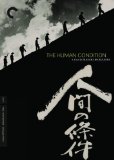| Reviews & Columns |
|
Reviews DVD TV on DVD Blu-ray 4K UHD International DVDs In Theaters Reviews by Studio Video Games Features Collector Series DVDs Easter Egg Database Interviews DVD Talk Radio Feature Articles Columns Anime Talk DVD Savant Horror DVDs The M.O.D. Squad Art House HD Talk Silent DVD
|
DVD Talk Forum |
|
|
| Resources |
|
DVD Price Search Customer Service #'s RCE Info Links |
|
Columns
|
|
|
Human Condition: Criterion Collection, The
The Criterion Collection // Unrated // September 8, 2009
List Price: $79.95 [Buy now and save at Amazon]
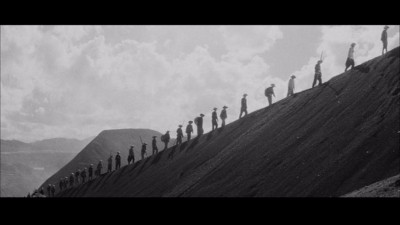
The Film:
Though a strong admirer of director Masaki Kobayashi's body of work, actor Tatsuya Nakadai, and Japanese cinema as a whole, Criterion's presentation of The Human Condition marks the first time that this remarkable cinematic achievement has fallen in front of these film-loving eyes. Soldiering on for nearly ten hours (approximately 579 minutes), it's not a simple undertaking to soak in the entirety of its message-driven girth; however, Kobayashi's incredible talent behind the camera transforms this near endless anti-war piece into an evocative marriage between pacing and dramatic zeal. Don't let the runtime spook you, as the experience in soaking in Masaki Kobayashi's epic-scaled drama is, without question, one worth enduring -- and easily one of the greatest overall accomplishments in cinema.
The Human Condition, adapted from the six-part series of novels from Gumikawa Junpei, focuses on Tatsuya Nadakai as Kaji, a pacifist shoehorned into the infrastructure of the Japanese military in the middle of World War II. His story is segmented into three phases of his life, each offering different insights into human interaction and perseverance in times of strife. Along the way, this body of work focuses on Kaji's transformation and how it affects both him and the relationship he has with his wife, Michiko (Michiyo Aratama). Humanism becomes the core focus, showing how one man -- a critic of everything the war stands for, from the centric military structure to the cause of the war itself -- tries to stifle and alter the dangerous flow of nationalism, bull-headed ranking, and mistreatment of both prisoners of war and lower-level soldiers that fueled the Japanese WWII energy. Infused with lyrically spellbinding cinematography from Yoshio Miyajima (Kwaidan) and a powerhouse transitory performance from Tatsuya Nakadai (Harakiri) in his first leading role, The Human Condition's precision in dramatic timing makes every motive-driven minute fly by with heartrending force. Note: mild spoilers follow, thought the info doesn't take away from each film's overall impact.
Human Condition I (aka No Greater Love) -- Parts I and II
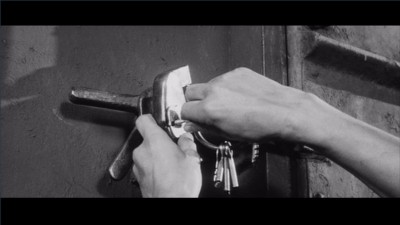 "To achieve the greater goal, we must overlook the small mistakes".
"To achieve the greater goal, we must overlook the small mistakes". Kabayashi starts his trilogy by introducing us to pre-war Kaji, a timid yet passionate student with fiery discord for the war -- and a call to arms slip with his name on it. The government, however, has a different idea for him; after a meeting with a high-ranking official about a report he composed on how to improve both conditions and productivity of a specific mine, he's sent to a prisoner-of-war (POW) camp in Japan-occupied Manchuria to assist in increasing ore production. This grants him immunity from the draft, even though he knows what this means regarding the terrible conditions of the camp. When he arrives, he learns that he'll have to find a way to increase output 20% by way of 600+ Chinese slaves, considered spoils of war. Instead of taking the standard approach implemented by the Japanese military stationed there -- essentially beating the work out of the starved, unhappy men -- he tries to find ways to humanize them under their "ownership" and help them tread water as long as they can.
As the Chinese men first stumble out of the train they arrive on, starving, sickly, and dying, the parallels drawn between them and disposable resources -- namely the ore they're mining for -- gains steam. It's at this point very early on that The Human Condition really shows that it's not going to pull any punches, as it thrusts the viewer head-on into the gut-wrenching filth of these robbed lives. They're nothing more than forced tools for output, and their treatment as such turns into a haunting portrait within the work camp. Implementation of electrified barbed wire, simply carnal motivators with Chinese prostitutes, and Japanese/Chinese scheming to profit from their scattered escape attempts from the camp litter the storyline, while fat and happy bureaucratic military types shuffle and bury them left and right. Kobayashi's film also shows the effects that these bigwigs have in beating down opposition to their tried-and-true principles, exerting both physical and psychological force to, hopefully, break them like animals.
Kaji's fight to build an actual relationship with the workers and to give them basic rights as humans becomes the enduring positive element in this bleak, affective anti-war portrait, something of a ray of light amid the unfaltering oppression generated by the war-crazed military and the Japanese "Gestapo", the Kempeitai. His relationship with the previous, more traditionally-minded supervisor, Okishima (Sô Yamamura), becomes both a give and take element in molding Kaji's mentality. During this process, he himself breaks a bit by witnessing rather trying exercises on the human spirit -- such as the effect of prostitutes on these desperate men, some of which are appreciative and others whom see through their usage as an "incentive" to work. Though an educated man, Kaji is taken through a barrier-breaking path showing that individuals oftentimes don't fit neatly into groups. This crosses over to many of the supporting characters in the film; a motive-swinging prostitute with breezy morals, a young Chinese upper-level worker in the camp named Chen who's wedged between the needs of his countrymen and the pressure of the Japanese, and a couple -- one a Chinese worker, the other a Chinese prostitute -- that find a natural love under these tumultuous circumstances.
Considering all this, and taking the heartrending yet flawless ending to heart, The Human Condition I easily stands on its own as a masterful piece of filmmaking. Subtlety behind Kaji's broken innocence and contorting sanity becomes nothing less than enveloping, as we're taking closer and closer to the boundary separating the Japanese and Chinese as individuals. The tension that mounts between Kaji's short list of supporters and the whole of the Japanese army carries a symbolic property, showcasing that sometimes that a "greater good" is sometimes misconstrued as the good of higher-ups and not of their constituents. Even without the remaining chapters, this particular story spoke to me in a way that instills bravery and drive behind the things that your heart tells you to be right -- not just a civil duty to do something that appears right, but actually listening to your heart when it tells you that something is devastatingly wrong in a situation where very, very little is right.
Human Condition II (aka The Road To Eternity) -- Parts III and IV
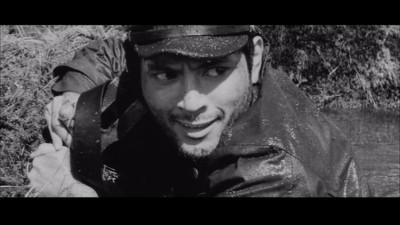 "Men are like springs. The more pressure, the more they spring back".
"Men are like springs. The more pressure, the more they spring back". Circumstances have plucked Kaji away from his work at the ore mine (reasons that'll be left our here, at the behest of spoiling the story), landing him at the front lines as a new recruit soldier for the Japanese army. Weathered from his time at the Manchurian POW camp, he has to adjust to being a non-violent individual directly under the thumb of the violence-hinged Japanese military during WWII. To make matters worse, word has also followed Kaji to basic training that he helped the Chinese workers in the labor camp -- thus labeling him a Red, or a supporter of the opposition. It's a fact that follows him all the way to the lines of WWII, where he's thrown head-on into the very thing he's always feared: witnessing death and violence in the name of something he doesn't believe in.
The second installment of The Human Condition takes the events from the work camp and transposes them into Kaji's troubles in the soldier barracks. He's forced to witness volatile veteran / rookie relationships, along with how the military mind has tweaked the older soldier's mindset into one with nothing more than rank and bloodlust for the enemy -- and weaker soldiers -- in tow. The gradation of human interaction gets purposefully muted throughout basic training, creating an environment that's too rigid to allow human development underneath the battery of Japanese war-focused energy. We witness how Kaji's wife copes with her husband being shifted from the work camp to the front line, how the bureaucratic higher-up Japanese military deal with Kaji as a Red, and how Kaji befriends and defends a lesser physical soldier. It also illustrates the way Kaji has become a martyr or sorts for normal humans, especially after he fights for separation between newly-recruited soldiers and those veterans who have been irreparably changed.
Most of this second installment, however, can best be lumped into a portrayal of what it's like to be in "the shit". It's meant to be the primal core separating the two other films that bookshelf The Human Condition, as well as an accurate depiction step-by-step of the pains that Kaji attempted to avoid. His sallow disposition speaks volumes, as he's almost like a semi-defeated ghost of himself fighting to pump vicarious life into the non-jaded men about to delve into this world of kowtowing to misguided Japanese militants. In that, the emotional resonance relies more on beautifully-captured visual imagery than a dynamic deconstruction of humanity. Yes, war is hell, and Kobayashi wants to make certain than the unjustified elements of this war are open for viewing like a fresh wound.
What many might not realize, as it gets buried at the center of a truly impactful human drama, is that Kobayashi's construction of the WWII battle line between the Japanese and the Soviet army late in Human Condition II easily stands as one of the better representations of war-time conflict. Featuring several large-scale tanks, exquisite costume work on the torn-to-shreds uniforms, and an environment rife with properly dug trenches and fox holes, the combination between an eye for detail and exquisitely-shot sequences really capture the intensity. An amazing job is also done in keeping Tatsuya Nakadai in-character as he shifts between the strong yet passive student from the first installment into this jaded, weaker-willed pacifist leading men onto the battlefield. It wouldn't be at all surprising to hear that Tom Hanks character from Saving Private Ryan was modeled from Kaji in the second half of this film, as they share the same cathartic, comrade-minded disposition as they lead their men onto the battlefield.
Human Condition III (aka A Soldier's Prayer) -- Parts V and VI
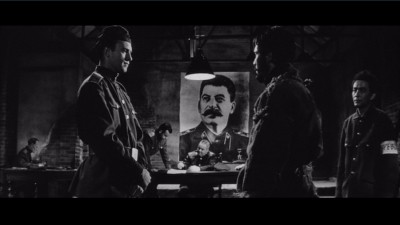 "When it's kill or be killed, you change".
"When it's kill or be killed, you change". As the battle winds down from the second installment, the conclusion to The Human Condition body of work focuses on the cascading effects on the soldiers following their skirmish with the Soviets. It's not as if the men are simply airlifted off of the battlefield once all is said and done; starving and without any form of home base or set destination whatsoever, Kaji and a few survivors -- both soldiers and commoners from a nearby town -- march on and struggle to find food and shelter while the violence dies down. They trample through the woods and stumble across fallen yet still vivacious Japanese squadrons, all while bickering among them about the futility of staging a "final stand" -- showcasing a rapid deflation of the Japanese military mentality.
Most of the first two-thirds focuses on lots -- and lots -- of walking between points and biting interactions with those effected by the war, but the core internal focus lies in the fact that Kaji, a tried-and-true man against violence and bloodshed, has been forced to kill in dire circumstances. Not only that, but a floodgate of sorts that bridled his rage has been demolished, deeming it a necessary evil for him to kill, and kill, and kill. Kobayashi instills a sense of furious trampling in Kaji that has taken him over, drawing some very mild comparisons between humans and cornered animals amidst a battle rage. Where animals see it as a necessity for survival, so does Kaji in his drive to return to Michiko; witnessing his deconstruction is not only heated and powerful, but also surprisingly innate.
Although the entire conclusive film to Kobayashi's trilogy showcases Kaji's trials and tribulations post-war, it's within the last hour of The Human Condition III where everything wraps around full-circle -- as Kaji is captured as a POW for the Soviet Army. He's entrenched in the very network of activity that he tried so desperately to both avoid and restructure, while enduring the same labors as the Chinese men he fought so bravely for. Witnessing his continued plummet into desperation becomes something of a farce, as phrases come back to haunt him around every angle. Many recurring themes and images start to echo in this third installment, such as the repetition of sharp lines in cinematography (indicative of the false representation of elements in this battle being "black and white") and several phrases, such as talks of the "greater good" from the mouth of another misguided Japanese soldier. Everything becomes enormously cyclical, which takes The Human Condition along the lines of Buddhist theory behind Karma -- though, as we can see, Kaji deserves very little of what he gets. That's the domineering power of war.
The Human Condition III leaves you desiring a conclusion, in the form of some catharsis near the close that justifies everything that we've seen -- an ultimate resolution. At this point, we're so bereft from the emotional torment that we just want something to wrap up in the end and give us a finite "reward" for the torment. It does, thankfully, closing in the same snowy fashion witnessed at the first embrace between Kaji and Michiko. Are we left satisfied? Maybe so, maybe not, but it's not the objective of this story to obtain satisfaction. That's not the humanistic response it desires; instead, it taps directly into the more rationale-based aspects of humanism, coming out in the fashion that we'd expect after Kaji endures years of undeserved, contorted torment by way of misguided Japanese ideals. Though potent largely because of the stark comparison between pre-war Kaji and post-war Kaji, the vigorous and fickle dynamics between our "hero" and his enemies late in the film boost it to quite an affective level on its own steam.
The DVD:
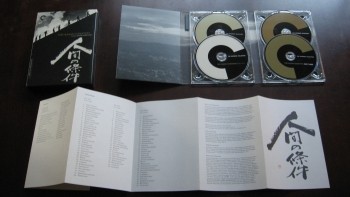 | 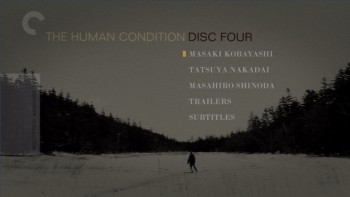 |
Criterion Collection Spine #480 befalls on The Human Condition, contained in a beautifully-designed four disc presentation with splendid artwork both on the inside and out. Though simple in concept, the gradual darkening of each "C" on the discs is a nice touch. Inside, a Booklet can be found that lists credits for both the film and the DVD production, a chapter listing, and an essay entitled "The Prisoner" from Philip Kemp.
Video and Audio:
Don't tell Criterion this, but The Human Condition could have been presented in the worst possible fashion, torn up and misframed to hell, and it'd still be a worthwhile purchase -- just as long as we're able to soak in this masterful piece of filmmaking. However, as per their steadfast and infinitely appreciated modus operandi, they have presented The Human Condition in a beautifully-rendered trio of 2.35:1 anamorphic widescreen transfers that do a tremendous job of presenting the material on three discs. Taken from new 35mm prints and created on their Spirit Datacine scanner, these digital images have also been put through the clean-up ringer to look their nearly damage-free, crisp best. The result is extremely fine and impressively rendered, if slightly uneven in a few spots; the first two films showcase some contrast issues early on, blooming a bit during brightly-lit sequences, while some pixelation and very faint edge halos can also be picked up across the entirety of each disc. The digital grain couldn't possibly be avoided if Criterion wanted to keep The Human Condition -- a film nearly ten hours long -- on three discs (with the fourth being the supplements, addressed later).
Aside from those two quibbles, we're working with three pinnacle visual presentations of classic Japanese cinema -- the third, likely taken from higher-grade film stock, looking a bit crisper and more well-balanced. Black levels achieve extremely dark renderings at times, rarely seeming too gray or too black for disbelief. Fine details, such as the weave in burlap sacks, leaves in a forest, grains from a satchel, skin texture, and small details in scenery all showcase prominent tangibility. Some of the texture really took me aback, as I had to remind myself that this wasn't a high-definition presentation. That's about the best compliment that can be dished out to a standard-definition presentation of a three-hour-plus film stored on one DVD. Could The Human Condition have looked a bit better by spreading it across, say, six discs instead of three (90-minutes per disc)? Possibly, but it'd be hard to imagine a better image for Kobayashi's film on this per-disc basis, something that's far more important that a slight enhancement in inherent digital flaws.
Audio is available in Dolby Digital Mono for Human Condition I and II, with Dolby Digital 4.0 available for The Human Condition III. The mono tracks were taken from a 35mm optical sound print and remastered at 24-bits, which results in a very smooth, distortion free sound design. Naturally, the films gravitate towards dialogue instead of dynamic properties, so speech preservation is the most important thing -- and this track tackles it well, without a single noticeably instance of high-pitched hiss or pops in the soundtrack. Effects, though naturally higher-pitched and without much resembling lower-level bass, remain crisp and clean, while the score thunders to the best of its ability around the higher and mid-range frequencies. The third film, one that mirrors the first two in speech-drive dynamics, receives a 24-bit remaster from the original 4-channel elements. Though it carries channels leading to the sides and rear, it's mostly a lightly-expanded mono track without much else in the way of extra audio oomph. Instead, the dialogue remains well-pitched and wholly audible to the ears, naturally a little bit cleaner than the mono tracks, with a slightly more active lower-frequency channel involving the musical score. White, well-placed optional subtitles, which are excellent as usual, are only available in the English language.
Special Features:
 1993 Interview with Masaki Kobayashi (13:34, 4x3):
1993 Interview with Masaki Kobayashi (13:34, 4x3): This interview, from a Director's Guild of Japan piece with director Masahiro Shinoda as the questioner, chronicles Kobayashi's experience in assembling The Human Condition. He discusses the process in electing to use cinematographer Miyajima instead of Shochiku's other photographers, the mass of dailies piled on his desk on New Year's Eve with the film scheduled for a January 15 release date, and how the Tokyo Giants baseball team came to watch a specific scene in the film -- as well as the connections between Kaji's character and Kobayashi's real-life experiences. An easter egg (0:57, 16x9) found underneath the selection text, taken from the Masahiro Shinoda video appreciation on the disc, reveals a fact or two about the interview.
Tatsuya Nakadai 2009 Interview (17:41, 16x9):
In this interview put together specifically for the Criterion Collection, Nakadai discusses his relationship to the film and to director Kobayashi. He dives into the process of casting Kaji, connecting with his character by going through military drills, and blitzing through read-throughs with Kobayashi and So Yamamura. He reflects on a hard-learned lesson about dialogue and scripting that he learned from Kobayashi, as well as a scene where the punches he receives from 20+ soldiers weren't faked -- and how it added an aesthetic realism to the final product. An easter egg (1:39, 16x9), found underneath the selection text, reveals a fascinating insight on Kobayashi's feelings towards Nakadai acting in a certain Akira Kurosawa film.
Video Appreciation from Masahiro Shinoda (24:40, 16x9):
Director Shinoda offers a very thoughtful arrangement of ideas regarding Kobayashi as a director for this Criterion-exclusive feature, especially his sprawl outside of the dramatic box that differed from more encapsulated Japanese directors like Yasujirō Ozu. He discusses the effects that being a POW had on the anti-war Kobayashi, as well as how he ended up being detained in Okinawa. Focusing on The Human Condition, Shinoda also reflects on how Kobayashi drew attention to realistic details to give it a dramatic punch, the uniqueness of the film's Chinese resistance in regards to Japanese cinema at the time, and the unabashed presentation of the Soviet Union in the film. Three easter eggs (3:03, 0:56, 1:21, 16x9)can also be found directly underneath the text that discussed assorted topics, from Soviet tanks to the nude scene in the film.
Three extensive Trailers (4:34, 2:42, 2:56, 16x9), one for each of The Human Condition films, are also available in anamorphic widescreen -- though sporting a thick windowbox.
Final Thoughts:
Yes, it's a ten-hour piece of filmmaking, and yeah, it's an $80 set from Criterion. However, every ounce of time and money invested in The Human Condition will offer a cinematic return ten-fold. Boasting one of the most resonant, deeply moving anti-war narratives paced in a fashion that never runs out of steam over its massive length, Masaki Kobayashi's humanist trilogy offers deeply-rooted analyses on the complex nature of war-torn humanity. It addresses timeless themes regarding the futility of fighting unjust wars, as well as the harrowing effects of misguided nationalism. Moreover, Kobayashi does it all in a way that's phenomenally performed and gorgeously shot, all while never letting the rhythm step close to being dry or dull.
The Criterion Collection continues their incredible work on mastering and supplements with this Highly Recommended affair for The Human Condition on DVD, offering an extremely impressive technical presentation of the near-ten-hour film across three discs and capping it off with several insightful supplements. It's a masterful film that's well worth the time, and a near-essential addition to any film-lover's collection of classic Japanese cinema.
|
| Popular Reviews |
| Sponsored Links |
|
|
| Sponsored Links |
|
|
| Release List | Reviews | Shop | Newsletter | Forum | DVD Giveaways | Blu-Ray | Advertise |
|
Copyright 2024 DVDTalk.com All Rights Reserved. Legal Info, Privacy Policy, Terms of Use,
Manage Preferences,
Your Privacy Choices | |||||||









